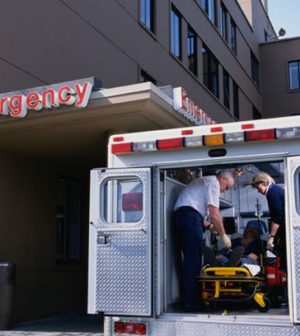- Navigating Your Midlife Crisis: Embracing New Possibilities
- City Raccoons Showing Signs of Domestication
- Mapping the Exposome: Science Broadens Focus to Environmental Disease Triggers
- One Week Less on Social Media Linked to Better Mental Health
- Your Brain Changes in Stages as You Age, Study Finds
- Some Suicide Victims Show No Typical Warning Signs, Study Finds
- ByHeart Formula Faces Lawsuits After Babies Sickened With Botulism
- Switch to Vegan Diet Could Cut Your Greenhouse Gas Emissions in Half
- Regular Bedtime Does Wonders for Blood Pressure
- Dining Alone Could Mean Worse Nutrition for Seniors
Time to Angioplasty Is Crucial for Better Heart Attack Outcomes

When a heart attack begins, the time it takes until the blockage in a coronary artery is cleared is critical in preventing further damage to the heart, a new study warns.
The amount of damage is directly related to how long it takes from the start of a heart attack to when patients receive an artery-clearing procedure called percutaneous coronary intervention, or angioplasty. The biggest obstacle to getting prompt treatment is delay before patients call the ambulance, the researchers said.
“For several decades, cardiologists have been taught ‘time is muscle,'” which means that the longer it takes for the blocked artery to be reopened, the greater the extent of heart muscle damage and the higher the risk of death, said study lead author Dr. Gregg Stone. He’s a professor of cardiology at Icahn School of Medicine at Mount Sinai in New York City.
The two components of “time” are how long it takes a patient to reach the hospital after symptoms begin, and how long it takes to make a diagnosis and transfer the patient to the cardiac catherization lab and open the artery, Stone said.
In angioplasty, a thin tube is threaded through a blood vessel to the site of the blockage. The tube has a tiny balloon at the end, which the doctor inflates to widen the artery and restore blood flow. A stent is then inserted to keep the artery open.
“For the last decade, there’s been a tremendous emphasis on reducing ‘door-to-balloon’ time, and U.S. hospitals have done a tremendous job on reducing this metric to usually 45 to 60 minutes for most patients,” Stone said.
Stone’s team found that the total time from symptom to balloon time was related to the size of the heart attack, death and heart failure.
“The implications are that given contemporary short door-to-balloon times, delays to hospital arrival are now a much more important predictor of [heart attack] size and adverse clinical outcomes,” he said.
Most of the delay results from patients not calling an ambulance soon enough, a problem that Stone said has worsened during the coronavirus pandemic.
“We need to redouble our efforts to educate patients to recognize the signs and symptoms of a heart attack, and activate 911 sooner to ensure faster hospital arrivals,” he said. “This is especially important in the COVID-era given patients having greater reticence to come to hospitals, leading to larger heart attacks and higher rates of mortality and heart failure.”
For the study, the researchers collected data on more than 3,100 heart attack patients who had angioplasties between 2002 and 2011. Patients were followed for a median of about a year. (Median means half were followed longer, half for less time.)
The longer it took from symptom-onset to repair, the more the heart attack size increased, Stone’s team found.
Several factors — older age, being a woman, having high blood pressure or diabetes, and a blockage in the left coronary artery — were associated with a longer time to angioplasty, the researchers found.
For every hour delay, the risk of death or hospitalization for heart failure within a year rose 11%, according to the report published online Jan. 14 in the journal Circulation: Cardiovascular Interventions.
The median time between the start of symptoms and treatment was 185 minutes, the study authors said.
Dr. Gregg Fonarow, interim chief of the division of cardiology at the University of California, Los Angeles, reviewed the study findings.
He said this and earlier studies underscore the critical need to not delay seeking immediate medical attention for symptoms that may be a heart attack.
“Time from symptom-onset to … treatment is a critical determinant of clinical outcomes in patients with heart attack and stroke,” Fonarow said.
“It remains critical for men and women to call 911 at the first potential symptom or sign of a heart attack or stroke,” he advised.
More information
For more on heart attacks, visit the American Heart Association.
SOURCES: Gregg Stone, MD, professor, cardiology, Icahn School of Medicine at Mount Sinai, New York City; Gregg Fonarow, MD, interim chief, division of cardiology, University of California, Los Angeles, and director, Ahmanson-UCLA Cardiomyopathy Center; Circulation: Cardiovascular Interventions, Jan. 14, 2021, online
Source: HealthDay
Copyright © 2025 HealthDay. All rights reserved.










